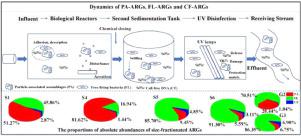Water Research ( IF 11.4 ) Pub Date : 2020-09-23 , DOI: 10.1016/j.watres.2020.116450 Kaifeng Yu , Peng Li , Yiliang He , Bo Zhang , Yihan Chen , Jinghan Yang

|
Serious concerns have been raised regarding antibiotic resistance genes (ARGs) with respect to their potential threat to human health. Wastewater treatment plants (WWTPs) have been considered to be hotspots for ARGs. In this study, high-throughput quantitative polymerase chain reaction (HT-qPCR) was used to profile size-dependent ARGs and mobile genetic elements (MGEs) divided by particle-associated (PA) assemblages (>3.0-μm), free-living (FL) bacteria (0.2 - 3.0-μm) and cell-free (CF) DNA (< 0.2-μm) in two full-scale WWTPs (plants A and B) and a receiving stream. The results revealed that FL-ARGs were predominant in WWTPs and the receiving stream, especially in the final effluent of both plants. More than 40 types of CF-ARGs and CF-MGEs were detected with absolute abundances ranging from 6.0 ± 0.7 × 105 to 1.0 ± 0.2 × 108 copies/mL in wastewater, and relatively high abundances were also detected in the final effluent of the two plants, suggesting that CF-ARGs were important sources spreading from the WWTPs to the receiving environment. Plant A exhibited higher log-removal of size-fractionated ARGs and MGEs than was observed for plant B, which was attributed to the enhanced settleability of PA assemblages and FL bacteria by additional macrophytes and chemical coagulants. Ultraviolet disinfection had limited effects on ARGs and MGEs of the PA and FL fractions, which was probably ascribed to the protective matrices of the particles and cell walls. The bacterial communities of the two plants were significantly different among the size fractions (p < 0.01). The variation partitioning analysis (VPA) indicated that the microbial community structures and MGEs contributed a variation of 68.2% in total to the relative abundance changes of size-fractionated ARGs. Procrustes analyses and Mantel tests showed that the relative abundances of ARGs were significantly correlated with bacterial community structures. These results suggested that the bacterial community structures and MGEs might have been the main drivers of the size-fractionated ARG disseminations. This study provides novel insights into size-fractionated ARGs and MGEs in full-scale WWTPs and may lead to the identification of key targets to control the spread of ARGs.
中文翻译:

规模化废水处理厂中与微生物群落相关的大小依赖性抗生素抗药性的揭示动力学
对于抗生素抗性基因(ARG)对人类健康的潜在威胁,人们提出了严重的担忧。废水处理厂(WWTP)被认为是ARGs的热点。在这项研究中,高通量定量聚合酶链反应(HT-qPCR)用于分析大小依赖的ARG和移动遗传元件(MGE)除以颗粒相关(PA)组合(>3.0μm),自由生活(FL)细菌(0.2-3.0-μm)和无细胞(CF)DNA(<0.2-μm)存在于两个满规模的WWTP(植物A和B)和接收流中。结果表明,FL-ARG在污水处理厂和接收流中占主导地位,尤其是在两种植物的最终废水中。检测到40多种CF-ARG和CF-MGE,绝对丰度范围为6.0±0.7×10 5废水的浓度达到1.0±0.2×10 8拷贝/ mL,并且在这两家工厂的最终废水中也检测到相对较高的丰度,这表明CF-ARG是从污水处理厂传播到接收环境的重要来源。与对植物B观察到的相比,植物A表现出对大小分级的ARG和MGE更高的对数去除,这归因于其他大型植物和化学混凝剂对PA组合和FL细菌的沉降性增强。紫外线消毒对PA和FL馏分的ARGs和MGEs的影响有限,这很可能是由于颗粒和细胞壁的保护基质所致。两种植物的细菌群落大小分数差异显着(p<0.01)。变异分区分析(VPA)表明,微生物群落结构和MGEs对大小分级的ARG的相对丰度变化的贡献总计为68.2%。Procrustes分析和Mantel测试表明ARGs的相对丰度与细菌群落结构显着相关。这些结果表明细菌群落结构和MGEs可能是大小分级ARG传播的主要驱动力。这项研究提供了对大规模污水处理厂中规模细分的ARG和MGE的新颖见解,并可能导致确定控制ARG扩散的关键目标。











































 京公网安备 11010802027423号
京公网安备 11010802027423号